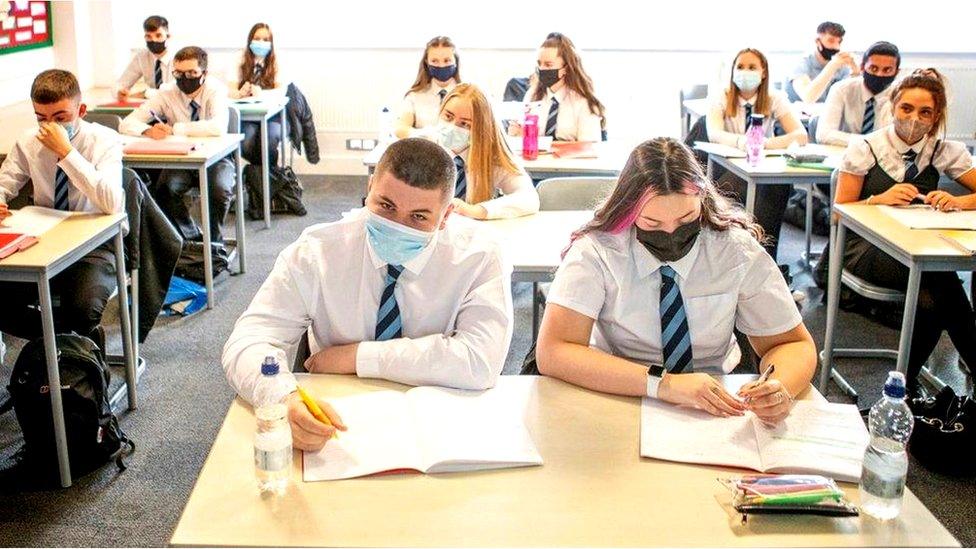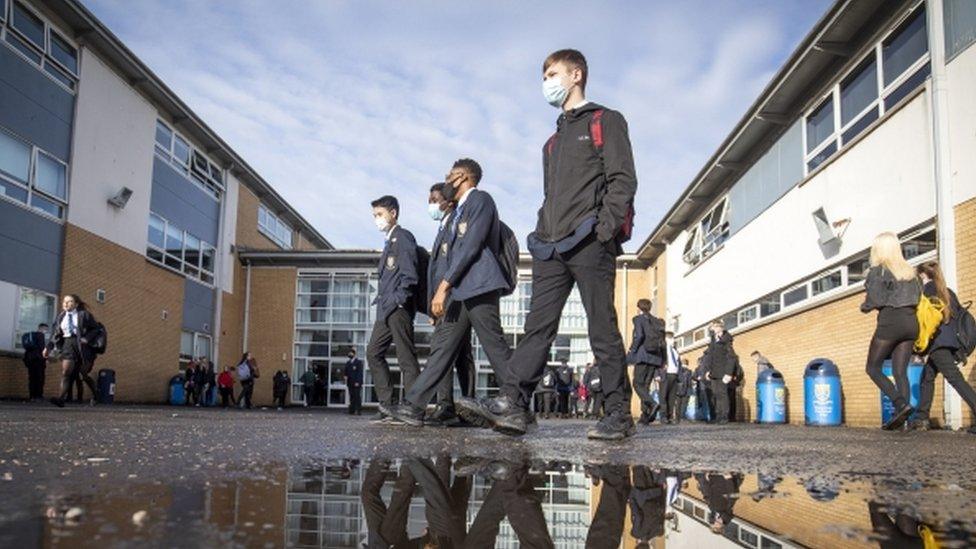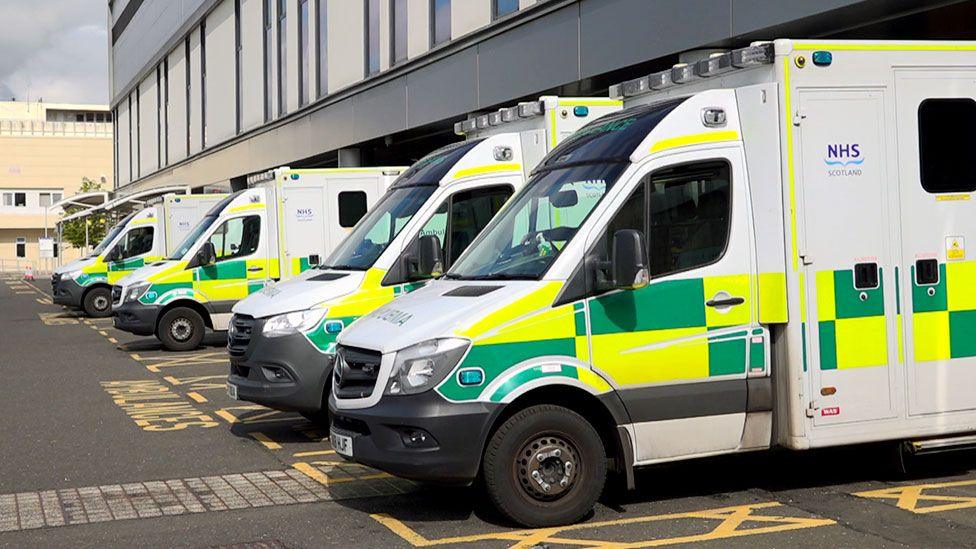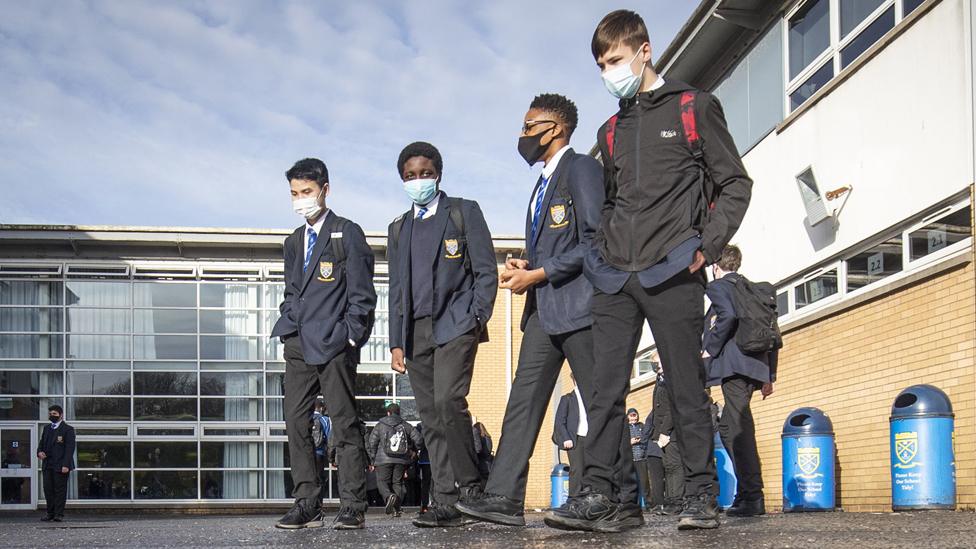Covid in Scotland: When do school pupils have to self-isolate?
- Published

Sitting next to someone in class does not automatically make someone a close contact
The current Covid surge has put schools back at the centre of the pandemic.
Covid case numbers have doubled in the past week, with the highest daily figure ever - 7,113 cases - confirmed on Sunday.
The deputy first minister, John Swinney, has said the surge was partly being fuelled by the return of schools after the summer holidays.
Last Friday's weekly data showed a rate of 190.1 cases per 100,000 in two to four-year-olds; 401.6 cases per 100,000 in five to 11-year-olds; 672.3 per 100,000 among 12 to 15-year-olds; and 1,198.5 cases per 100,000 in 16 to 17-year-olds.
To put that in perspective, the rate of cases per 100,000 of the general population was 435.9.
But with the virus ripping through schools, parents are confused when children are not being identified as close contacts to their classmates.
Many are unclear when, and for how long, children need to self-isolate - and who can ask them to. So what are the rules?
Who has to self-isolate?

Secondary pupils must wear face coverings at all times while in school
Everyone must self-isolate in line with NHS Inform guidelines, external if they have had a positive Covid test or virus symptoms.
But from 9 August, the rules changed for close contacts of a positive Covid case if they are under 18.
If you are aged between five and 18, you are a close contact if you live in the same household as a positive case, or if you have been identified by NHS Test and Protect as a close contact.
If this happens, you have to:
Self-isolate immediately and book a PCR test
If the PCR test is negative and you remain without symptoms, you can end self-isolation and return to school
If the PCR test is positive, stay in self-isolation in line with NHS guidance
If symptoms start at any time, go back to the self-isolation stage and book a PCR test
Under-fives do not have to self-isolate if they are a close contact if they stay symptom-free. They do not have to take PCR test, but it is encouraged if possible before returning to childcare and usual activities.
Can schools ask pupils to self-isolate?
No. Whole classes or groups are no longer routinely asked to stay at home.
The school should be contacted by Test and Protect to identify any potential close contacts and will then send out a "warn and inform" letter to let parents know there has been a case in the school.
Some schools have decided to inform parents if there has been a case in individual classes. Parents will be asked to remain vigilant for symptoms and to continue home testing for secondary pupils, but they will not ask people to isolate.
What is a close contact?
Sitting next to someone in class is no longer a guarantee of being deemed a close contact.
The Scottish government guidance says that close contacts are likely to be parents and siblings, those who have stayed overnight, and those who have had "clear, prolonged contact".
A close contact will now only be formally notified by local public health teams.
How long is self-isolation?
Self-isolation now only lasts as long as the wait for a negative PCR test result. This could be as little as one or two days.
What has the reaction been?
The general secretary of the EIS teaching union believes that in-school transmission between young people is partly behind the recent hike in infections.
Larry Flanagan told BBC Radio's Good Morning Scotland programme there should be a rethink about the recent changes.
He said: "We think the return to schools is definitely part of the overall scenario. The high infection levels in the community clearly will be reflected in schools. And given some of the changes in school, transmission between young people is certainly part of what we are seeing in terms of the high numbers.
"I think that's partly due to the fact that pupil close contacts are not automatically being required to get a PCR test and we think that is a mistake.
"If a young person is identified as a close contact then they should be getting a PCR test before they return to the classroom and that might have some impact on limiting the in-school transmission which is clearly taking place."

Whole classes are no longer having to isolate at home following a positive test
Parent and member of the 50/50 education campaign group, Louise McSorley, told the BBC: "I am still concerned that these classrooms have got many pupils in them and we do need to put in place mitigations.
"This is where we need to ensure we are continuing masks in schools. I know a lot of people don't want to do it - but it does reduce transmission.
"We need to be making sure ventilation is in place, the testing regime - all of these are needed and there may need to be occasions with some schools where if case rates are higher that we do need to look at using the bubble system again. Ultimately we need to get cases in the community down."
Education Secretary Shirley-Anne Somerville said the new rules came from analysing data over the past year. She said it was a targeted approach which identified children and young people who were higher-risk close contacts.
She said: "This means that fewer young people will have to self-isolate, and most will be asked to self-isolate for a much shorter period of time.
"Our revised approach reflects the significant changes in the public health impact of Covid achieved through high vaccination coverage, as well as evidence about the risks of infection and transmission amongst children, young people and staff in schools, set against the educational harms that result from large numbers of children and young people self-isolating.
"To allow time to monitor the impacts of these changes, the majority of the mitigations that were in place in schools in the previous term will be retained for up to six weeks."


When the relaxation to isolation rules in schools were announced earlier in the summer, they were welcomed by many parents and pupils.
Being forced to stay home and miss out on class time had become something of a lottery and the letter or call home was dreaded by many families.
Now the new rules are in force, for some it feels uncomfortable or even unsafe to have young people who have sat next to a positive case not even being required to take a test, let alone isolate.
This is the new approach and government and health officials believe it's the right one at this stage in the pandemic.
They'll be watching case numbers in schools closely over the next few weeks to see if the rules need to be tightened again.


Related topics
- Published29 August 2021

- Published25 August 2021
